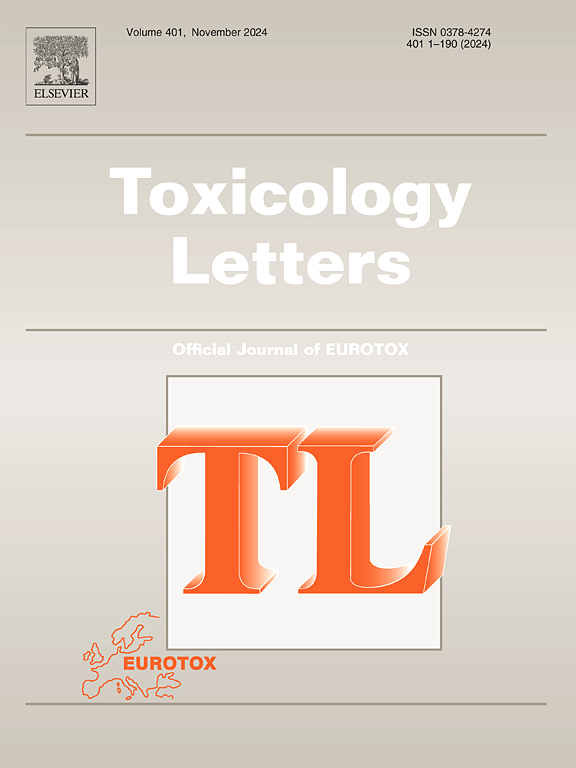除草剂2,4-二氯苯氧乙酸通过氧化应激激活AMPKα信号下游调控的凋亡途径诱导胰腺β细胞死亡
IF 2.9
3区 医学
Q2 TOXICOLOGY
引用次数: 0
摘要
2,4-二氯苯氧乙酸(2,4- d)是农业中常用的有机除草剂之一。有报道称2,4- d对哺乳动物细胞有不良影响。流行病学和动物研究表明,暴露于2,4- d与较差的血糖控制和胰腺β细胞功能受损有关。然而,关于2,4- d在β细胞中诱导的毒理学效应的信息有限,潜在的毒理学机制尚不清楚。本研究结果表明,2,4- d暴露(30-500 μg/mL)显著降低细胞活力,诱导线粒体功能障碍(包括线粒体膜电位(MMP)丧失、胞质细胞色素c释放增加、Bcl-2和Bax蛋白表达改变),并引发RIN-m5F β-细胞凋亡事件(包括凋亡细胞数量增加、caspase-3活性增加、caspase-3/-7和PAPR激活)。伴有胰岛素分泌抑制。细胞暴露于2,4- d环境中还可以激活JNK、ERK1/2、p38和amp活化的蛋白激酶(AMPK)α以及活性氧(ROS)的产生。用化合物C(一种AMPK抑制剂)和抗氧化剂n -乙酰半胱氨酸(NAC)预处理细胞,而不是用SP600125/PD98059/SB203580(分别是JNK/ERK/p38的抑制剂)预处理细胞,可以明显减弱2,4- d引发的AMPKα磷酸化、MMP丢失、凋亡事件和胰岛素分泌功能障碍,效果与转染AMPKα1特异性siRNA相似。值得注意的是,用NAC缓冲ROS的产生明显地阻止了2,4- d诱导的ROS的产生和AMPKα的激活,但无论是化合物C还是AMPKα1特异性siRNA转染都不能有效地减少2,4- d诱导的ROS的产生。总之,这些发现表明,诱导氧化应激激活的AMPKα信号是2,4- d触发的线粒体依赖性凋亡的关键机制,最终导致β细胞死亡。本文章由计算机程序翻译,如有差异,请以英文原文为准。
The herbicide 2,4-dichlorophenoxyacetic acid induces pancreatic β-cell death via oxidative stress-activated AMPKα signal downstream-regulated apoptotic pathway
2,4-Dichlorophenoxyacetic acid (2,4-D) is one of commonly and widely used organic herbicides in agriculture. It has been reported that 2,4-D can induce adverse effects in mammalian cells. Epidemiological and animal studies have indicated that exposure to 2,4-D is associated with poorer glycemic control and impaired pancreatic β-cell function. However, limited information is available on 2,4-D-induced toxicological effects in β-cells, with the underlying toxicological mechanisms remains unclear. Herein, our results showed that 2,4-D exposure (30–500 μg/mL) significantly reduced cell viability, induced mitochondria dysfunction (including the mitochondrial membrane potential (MMP) loss, the increase in cytosolic cytochrome c release, and the change in Bcl-2 and Bax protein expression), and triggered apoptotic events (including the increased population of apoptotic cells, caspase-3 activity, and caspase-3/-7 and PAPR activation) in RIN-m5F β-cells, accompanied with insulin secretion inhibition. Exposure of cells to 2,4-D could also evoke JNK, ERK1/2, p38, and AMP-activated protein kinase (AMPK)α activation as well as reactive oxygen species (ROS) generation. Pretreatment of cells with compound C (an AMPK inhibitor) and the antioxidantN-acetylcysteine (NAC), but not that SP600125/PD98059/SB203580 (the inhibitors of JNK/ERK/p38, respectively), obviously attenuated the 2,4-D-triggered AMPKα phosphorylation, MMP loss, apoptotic events, and insulin secretion dysfunction,as similar effects with the transfection with AMPKα1-specific siRNA. Of note, buffering the ROS production with NAC obviously prevented the 2,4-D-induced ROS generation as well as AMPKα activation, but the either compound C and AMPKα1-specific siRNA transfection could not effectively reduce 2,4-D-induced ROS generation. Collectively, these findings indicate that the induction of oxidative stress-activated AMPKα signaling is a crucial mechanism underlying 2,4-D-triggered mitochondria-dependent apoptosis, ultimately leading to β-cell death.
求助全文
通过发布文献求助,成功后即可免费获取论文全文。
去求助
来源期刊

Toxicology letters
医学-毒理学
CiteScore
7.10
自引率
2.90%
发文量
897
审稿时长
33 days
期刊介绍:
An international journal for the rapid publication of novel reports on a range of aspects of toxicology, especially mechanisms of toxicity.
 求助内容:
求助内容: 应助结果提醒方式:
应助结果提醒方式:


